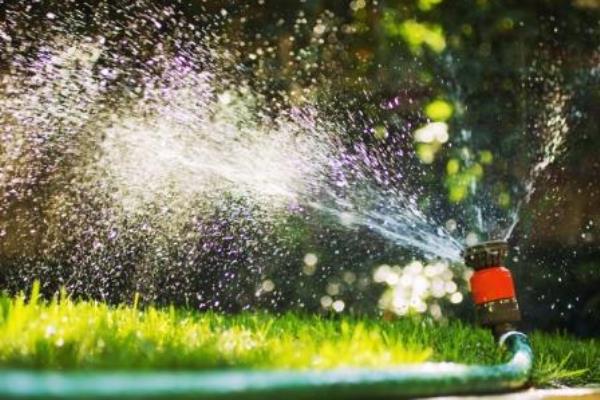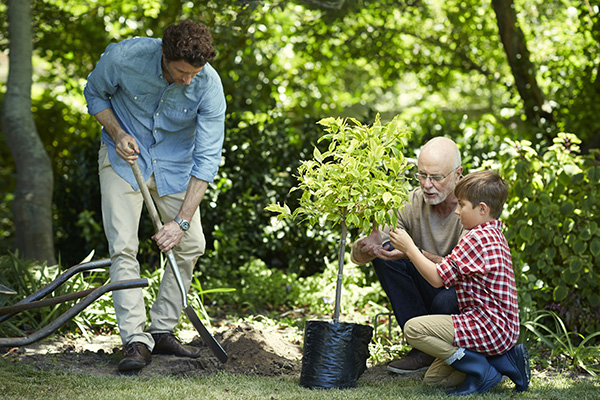Summer is an excuse to spend as much time outside as possible. But if your lawn is looking less than lush, you may be tempted to lock yourself indoors all season. Don’t let a lack of lawn-care knowledge keep you from enjoying all your yard has to offer. With the proper attention and care, your grass can become the envy of the neighborhood in no time.
1. TEST YOUR SOIL.
There are plenty of rules of thumb to follow when caring for grass, but it’s also important to understand your lawn’s unique needs. A great way to get smarter about lawn care is by testing your soil. High pH is a sign of soil that’s too alkaline, and low pH means it’s too acidic. These levels can be balanced by adding either lime to raise it or sulfur to lower it. A soil test kit will help determine your soil’s pH levels as well as any other nutrients it may be lacking. That way you’ll have an idea of what to introduce to your dirt to keep your lawn looking its best.
2. ELIMINATE WEEDS WHEN THEY APPEAR.
Weeds are a proud lawn-owner’s most notorious enemy. Preventing them from sprouting up year after year is easier said than done, but there is a way to protect your lawn before things get out of hand. When dandelions rear their heads in the spring, it’s best to eliminate them as soon as possible. A spray of herbicide should do the trick, but pulling up dandelions by the roots is the safest and most effective method of attack. Getting rid of dandelions before they go to seed can prevent up to 2,000 seeds from scattering across your lawn.
 3. DON’T MOW TOO LOW.
3. DON’T MOW TOO LOW.
Having a well-manicured lawn doesn’t necessarily mean giving it a close trim. When you cut your grass too low, you run the risk of damaging the grass’s blades. This makes it harder for it to store nutrients and complete photosynthesis, which can lead to a lawn that’s brown and dry. Different grass varieties should be cut at different lengths, but a good guideline to follow is the one-third rule. By never trimming more than a third of a blade off at once you can keep your yard looking healthy and well-maintained all season long.
4. WATER IT IN THE MORNING.
Whether you’re a morning person or not, committing to a healthy lawn means getting out of bed early. The afternoon sun can evaporate water before it hits the soil, and the cool night air is a perfect formula for fungus growth. The early morning, when the sun is still low in the sky and there’s less wind to scatter the droplets, is the best time of day to hydrate your grass. Sticking to a consistent watering routine of one to two mornings a week works for most lawns.
5. DON’T OVERFEED IT.
Even if your grass is getting plenty of water and sunshine, it’s still important to feed it a nutritious diet. Applying fertilizer every six to eight weeks should be sufficient. Well-watered grass requires the most fertilizer because it grows at a faster rate, while lawn-owners who are more conservative with their water can get away with feeding it a little less. When it comes time to actually spread your fertilizer, don’t overdo it: Estimating slightly under is always the safest bet.
 6. SPOT TRAIN YOUR PET.
6. SPOT TRAIN YOUR PET.
Sometimes your beloved canine companion can be your lawn’s worst enemy. If your lawn is spotted with unsightly brown patches, the high nitrogen content in your dog’s urine is likely to blame. One way to reduce this is by training your pet to pee in the same spot. Reserve an area of mulch or gravel for your dog to use every time they go out. If they ever happen to do their business on the lawn, pouring water on the affected zone should dilute the urine and salvage the grass before it loses its rich hue.
7. AERATE IN THE SPRING AND FALL.
One of the most important steps in maintaining a green lawn comes after the season has ended. By the time autumn rolls around there are fewer weed seeds and your lawn isn’t seeing as much wear-and-tear compared to the summer months, making it the ideal time to aerate your lawn. Punching small holes in the ground using a gas-powered aerator allows water, air, and nutrients to infiltrate the soil more easily. Complete this process up to twice a year (once in the fall and once in the spring) to keep your lawn thriving season after season.
Unwanted pests doing a number on your garden? Check out these Natural And Effective Pest-Control Techniques to keep pests at bay the safe way.










Don Goughenour says,
Like these tips!